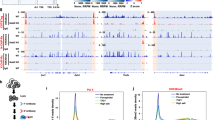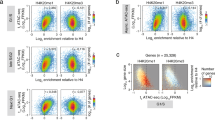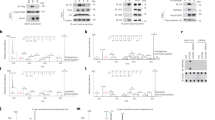Abstract
Post-translational modification of chromatin has profound effects on many biological processes including transcriptional regulation, heterochromatin organization, and X-chromosome inactivation1,2. Recent studies indicate that methylation on specific histone lysine (K) residues participates in many of these processes3. Lysine methylation occurs in three distinct states, having either one (me1), two (me2) or three (me3) methyl groups attached to the amine group of the lysine side chain. These differences in modification state have an important role in defining how methylated chromatin is recognized and interpreted4,5,6. Until recently, histone lysine methylation was considered a stable modification7,8, but the identification of histone demethylase enzymes has demonstrated the reversibility of this epigenetic mark9,10,11. So far, all characterized histone demethylases show enzymatic activity towards lysine residues modified in the me1 or me2 state9,10,11, leaving open the possibility that me3 constitutes an irreversible modification. Here we demonstrate that JHDM3A (jumonji C (JmjC)-domain-containing histone demethylase 3A; also known as JMJD2A) is capable of removing the me3 group from modified H3 lysine 9 (H3K9) and H3 lysine 36 (H3K36). Overexpression of JHDM3A abrogates recruitment of HP1 (heterochromatin protein 1) to heterochromatin, indicating a role for JHDM3A in antagonizing methylated H3K9 nucleated events. siRNA-mediated knockdown of JHDM3A leads to increased levels of H3K9 methylation and upregulation of a JHDM3A target gene, ASCL2, indicating that JHDM3A may function in euchromatin to remove histone methylation marks that are associated with active transcription12.
This is a preview of subscription content, access via your institution
Access options
Subscribe to this journal
Receive 51 print issues and online access
$199.00 per year
only $3.90 per issue
Buy this article
- Purchase on Springer Link
- Instant access to full article PDF
Prices may be subject to local taxes which are calculated during checkout




Similar content being viewed by others
References
Bird, A. DNA methylation patterns and epigenetic memory. Genes Dev. 16, 6–21 (2002)
Jenuwein, T. & Allis, C. D. Translating the histone code. Science 293, 1074–1080 (2001)
Martin, C. & Zhang, Y. The diverse functions of histone lysine methylation. Nature Rev. Mol. Cell Biol. 6, 838–849 (2005)
Flanagan, J. F. et al. Double chromodomains cooperate to recognize the methylated histone H3 tail. Nature 438, 1181–1185 (2005)
Jacobs, S. A. & Khorasanizadeh, S. Structure of HP1 chromodomain bound to a lysine 9-methylated histone H3 tail. Science 295, 2080–2083 (2002)
Min, J., Zhang, Y. & Xu, R. M. Structural basis for specific binding of Polycomb chromodomain to histone H3 methylated at Lys 27. Genes Dev. 17, 1823–1828 (2003)
Bannister, A. J., Schneider, R. & Kouzarides, T. Histone methylation: dynamic or static? Cell 109, 801–806 (2002)
Duerre, J. A. & Lee, C. T. In vivo methylation and turnover of rat brain histones. J. Neurochem. 23, 541–547 (1974)
Shi, Y. et al. Histone demethylation mediated by the nuclear amine oxidase homolog LSD1. Cell 119, 941–953 (2004)
Tsukada, Y. et al. Histone demethylation by a family of JmjC domain-containing proteins. Nature 439, 811–816 (2006)
Yamane, K. et al. JHDM2A, a JmjC-containing H3K9 demethylase, facilitates transcription activation by androgen receptor. Cell 125, 483–495 (2006)
Vakoc, C. R., Mandat, S. A., Olenchock, B. A. & Blobel, G. A. Histone H3 lysine 9 methylation and HP1γ are associated with transcription elongation through mammalian chromatin. Mol. Cell 19, 381–391 (2005)
Clissold, P. M. & Ponting, C. P. JmjC: cupin metalloenzyme-like domains in jumonji, hairless and phospholipase A2β. Trends Biochem. Sci. 26, 7–9 (2001)
Trewick, S. C., McLaughlin, P. J. & Allshire, R. C. Methylation: lost in hydroxylation? EMBO Rep. 6, 315–320 (2005)
Katoh, M. & Katoh, M. Identification and characterization of JMJD2 family genes in silico. Int. J. Oncol. 24, 1623–1628 (2004)
Gray, S. G. et al. Functional characterization of JMJD2A, a histone deacetylase- and retinoblastoma-binding protein. J. Biol. Chem. 280, 28507–28518 (2005)
Zhang, D., Yoon, H. G. & Wong, J. JMJD2A is a novel N-CoR-interacting protein and is involved in repression of the human transcription factor achaete scute-like homologue 2 (ASCL2/Hash2). Mol. Cell. Biol. 25, 6404–6414 (2005)
Bannister, A. J. et al. Spatial distribution of di- and tri-methyl lysine 36 of histone H3 at active genes. J. Biol. Chem. 280, 17732–17736 (2005)
Bannister, A. J. et al. Selective recognition of methylated lysine 9 on histone H3 by the HP1 chromo domain. Nature 410, 120–124 (2001)
Lachner, M., O'Carroll, D., Rea, S., Mechtler, K. & Jenuwein, T. Methylation of histone H3 lysine 9 creates a binding site for HP1 proteins. Nature 410, 116–120 (2001)
Peters, A. H. et al. Partitioning and plasticity of repressive histone methylation states in mammalian chromatin. Mol. Cell 12, 1577–1589 (2003)
Rice, J. C. et al. Histone methyltransferases direct different degrees of methylation to define distinct chromatin domains. Mol. Cell 12, 1591–1598 (2003)
Whetstine, J. R. et al. Reversal of histone lysine trimethylation by the JMJD2 family of histone demethylases. Cell 125, 467–481 (2006)
Sarraf, S. A. & Stancheva, I. Methyl-CpG binding protein MBD1 couples histone H3 methylation at lysine 9 by SETDB1 to DNA replication and chromatin assembly. Mol. Cell 15, 595–605 (2004)
Schultz, D., Ayyanathan, K., Negorev, D., Maul, G. & Rauscher, F. SETDB1: a novel KAP-1-associated histone H3, lysine 9-specific methyltransferase that contributes to HP1-mediated silencing of euchromatic genes by KRAB zinc-finger proteins. Genes Dev. 16, 919–932 (2002)
Kim, J. et al. Tudor, MBT and chromo domains gauge the degree of lysine methylation. EMBO Rep. 7, 397–403 (2006)
Huang, Y., Fang, J., Bedford, M. T., Zhang, Y. & Xu, R. M. Recognition of histone H3 lysine-4 methylation by the double Tudor domain of JMJD2A. Science 312, 748–751 (2006)
Zhang, X. et al. Structure of the Neurospora SET domain protein DIM-5, a histone H3 lysine methyltransferase. Cell 111, 117–127 (2002)
Acknowledgements
We thank J. Fang, B. Strahl, T. Jenuwein, L. Schmiedeberg, A. Verreault and Y. Shinkai for plasmids; X. Cheng and R. Cao for Dim5 protein and EZH2 complex, respectively; L. Lacomis for help with mass spectrometry; and technical assistance from C. Toumazou. This work was supported by NIH grants to Y.Z., P.T. and J.W. Y.Z. is an Investigator of the Howard Hughes Medical Institute. Author Contributions R.J.K. carried out most of the experiments in Figs 1–3and the Supplementary Figures; K.Y. generated recombinant protein; H.E.-B. and P.T. performed mass spectrometric analysis; Y.B., D.Z. and J.W. carried out the experiments in Fig. 4; R.J.K. and Y.Z. wrote the paper.
Author information
Authors and Affiliations
Corresponding author
Ethics declarations
Competing interests
Reprints and permissions information is available at npg.nature.com/reprintsandpermissions. The authors declare no competing financial interests.
Supplementary information
Supplementary Figures
This file contains Supplementary Figures 1–8. (PDF 1072 kb)
Supplementary Figure Legends
Text to accompany the above Supplementary Figures. (DOC 31 kb)
Supplementary Methods
Detailed description of the experimental methods used in this study. (DOC 50 kb)
Supplementary Notes
Bibliography of references cited in Supplementary Information. (DOC 26 kb)
Rights and permissions
About this article
Cite this article
Klose, R., Yamane, K., Bae, Y. et al. The transcriptional repressor JHDM3A demethylates trimethyl histone H3 lysine 9 and lysine 36. Nature 442, 312–316 (2006). https://doi.org/10.1038/nature04853
Received:
Accepted:
Published:
Issue Date:
DOI: https://doi.org/10.1038/nature04853
This article is cited by
-
In-silico guided chemical exploration of KDM4A fragments hits
Clinical Epigenetics (2023)
-
Carcinogenesis promotion in oral squamous cell carcinoma: KDM4A complex-mediated gene transcriptional suppression by LEF1
Cell Death & Disease (2023)
-
EZH2 interacts with HP1BP3 to epigenetically activate WNT7B that promotes temozolomide resistance in glioblastoma
Oncogene (2023)
-
H3K36 trimethylation-mediated biological functions in cancer
Clinical Epigenetics (2021)
-
Regulation of mammalian 3D genome organization and histone H3K9 dimethylation by H3K9 methyltransferases
Communications Biology (2021)
Comments
By submitting a comment you agree to abide by our Terms and Community Guidelines. If you find something abusive or that does not comply with our terms or guidelines please flag it as inappropriate.



